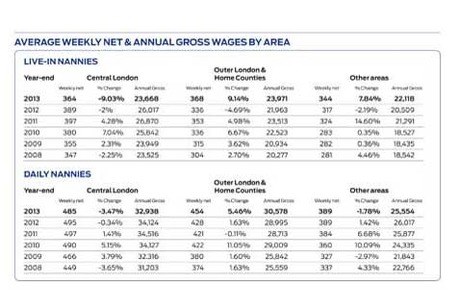Ups and downs for nanny salaries
Monday, February 3, 2014
Wage rises for nannies have been relatively small over the past year, according to the Nannytax annual nanny benchmark survey.

There were variations between live-in and live-out nannies, and in different areas of the UK, however, with a central London daily (live-out) nanny’s annual pay averaging £34,941 in 2013, a 2.39 per cent rise. A central London live-in nanny’s salary, meanwhile, dropped 5.39 per cent to £24,614.
The survey also found that:
- Demand for part-time nannies was high, but few families wanted to ‘nannyshare’.
- Demand for daily nannies was much higher than for live-in nannies.
- The proportion of nannies registering with Ofsted has fallen.
- Nannies from Eastern Europe were the second largest group after British workers.
Pay rates for both live-in and daily nannies, in central London, greater London and the Home Counties, and in the rest of the UK are shown in the table below.

Ofsted registration
The number of nannies registering with Ofsted fell this year to 67.6 percent, down from 73.4 per cent the year before.
Those who did not register said it was because it didn’t add anything to their career as a nanny (37.1 per cent), it wasn’t required by their employer (30.2 per cent) or they didn’t see the point (28 per cent).
Relatively few said it was too expensive (17.2 per cent) or too complicated (10.3 per cent).
Of those who registered, 71.5 per cent said it was because they were asked to by their employers – consistent with the families who employed an Ofsted-registered nanny, of whom 76.5 per cent said this was because they used Tax Free Childcare Vouchers.
Some 37.2 per cent of Ofsted-registered nannies said it made them more employable.
Nanny characteristics
Only around a third of nannies working in the UK are foreign, the survey found, with 64.5 per cent of employers saying their nanny was from the UK. This was followed by Eastern Europe (15.1 per cent), Western Europe (5.6 per cent), Australasia (3.6 per cent), China/South East Asia (3.4 per cent) and South America (2.2 per cent).
Nannies are typically older than the stereotype suggests, with 45.4 per cent aged 21-30 and 35.5 per cent aged 31-40.
Many are in the job as a long-term career – around a third had worked for one to four years as a nanny, and just over that number for more than 10 years. Only five per cent had been a nanny for less than a year.
Hours and contracts
Demand for full-time nannies has been steadily dropping, the survey found, with agencies saying demand for full-time live in positions has been ‘low’ since 2010 when it was ‘average’. Full-time daily nannies had been in ‘high’ demand, but this has dropped to ‘average’ since 2012.
Families show high demand for part-time nannies, but the call for nannyshares is consistently low.
Nannies were asked to describe their current employment situation:
- Full-time live-in nanny 7.6 per cent
- Part-time live-in nanny 1.3 per cent
- Full-time live-out nanny 54.4 per cent
- Part-time live-out nanny 28.9 per cent
- Working in a nannyshare 4.1 per cent
- Not currently working as a nanny 3.8 per cent
Nannytax has been campaigning for the nanny industry to agree wages in gross figures rather than net. However, around half of both employers and nannies said that the salary was agreed as a net figure.
- More information at www.nannytax.co.uk






